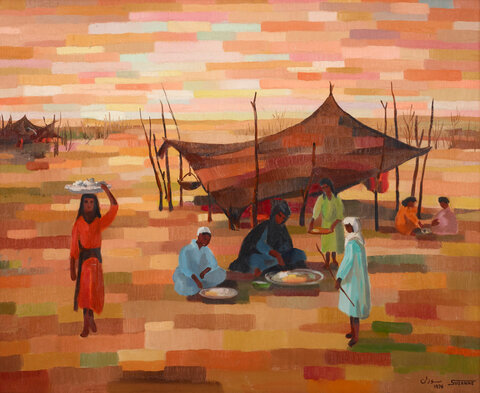Suzanne Al-Cheikhli’s Untitled, 1976 depicts the daily life of a Bedouin Iraqi family within the desert environment. At the upper right-central part of the painting we see a brown tent bordering the painting's horizon line, held up by wooden branches and sticks. The tent serves as the focal point of the painting’s composition, around which the characters are distributed. The Bedouin women and men are all busy with their daily life duties: the man and young boy seated in front of the tent are eating, a young woman in green is serving them food, while the woman in the red abaya, the only subject facing the viewer, is carrying a tray on her head as she walks ahead. In the background, we see two other younger subjects also eating, and further behind, hidden by the tent we see the red silhouettes of other figures carrying on with their chores or daily life. Further behind, at the left corner of the horizon, is another similar tent with red shapes suggesting another Bedouin community also engaged in similar actions. Through this simple snapshot of daily life, Al-Cheikhli brings out the elements that distinguish the subjects’ belonging to the Iraqi desert environment and the relevant aspects that mark their culture. It also showcases Al-Cheikhli’s thematic and stylistic approach through her focus on presenting the local character of Iraq using her signature mosaic-like backgrounds as well as the loose brushstrokes that characterized many of her works.
This piece celebrates the Iraq that Al-Cheikhli, originally born in France and later becoming an Iraqi citizen, fell in love with and tried to represent throughout her works. She had arrived in Iraq after marrying the renowned Iraqi artist Ismail Al-Cheikhli in the early 1950s. During this period, she and her husband joined the Pioneers Group in 1953, co-founded by Faik Hassan. Members of this group dedicated their work to Iraqi landscapes and social urban and rural life. The Pioneers would go on rides and picnics to the suburbs of Baghdad and northern Iraq, as they tried to incorporate nature and Iraqi life into their artistic practices. Their portrayals focused on bringing out the colors of their surroundings and prioritized compositions that revealed the Iraqi environment. In the process, the group attempted to introduce the western styles that they had studied abroad, while maintaining the authenticity of Iraqi art.
Suzanne Al-Cheikhli’s work followed the same ethos as she focused on depicting Iraq’s popular culture and its local scenes, such as its markets and souks, the alleys of the city, the marshes, the palm trees, the farmers, and the bedouins. She brought the culture and the landscape to life through her paintings by prioritizing the everyday scenes that reflected the rhythm of daily life.
Al-Cheikhli became a member of the Iraqi Artist Syndicate, the Iraqi Fine Artists Association, and the Association of Plastic Artists, and displayed at exhibitions across the world throughout her lifetime. She also taught art at local schools in Baghdad for more than three decades. Today, she is considered a renowned Iraqi artist who played a vital role in maintaining the nation’s cultural heritage.
Signed in Arabic and English and dated in English front lower left.




